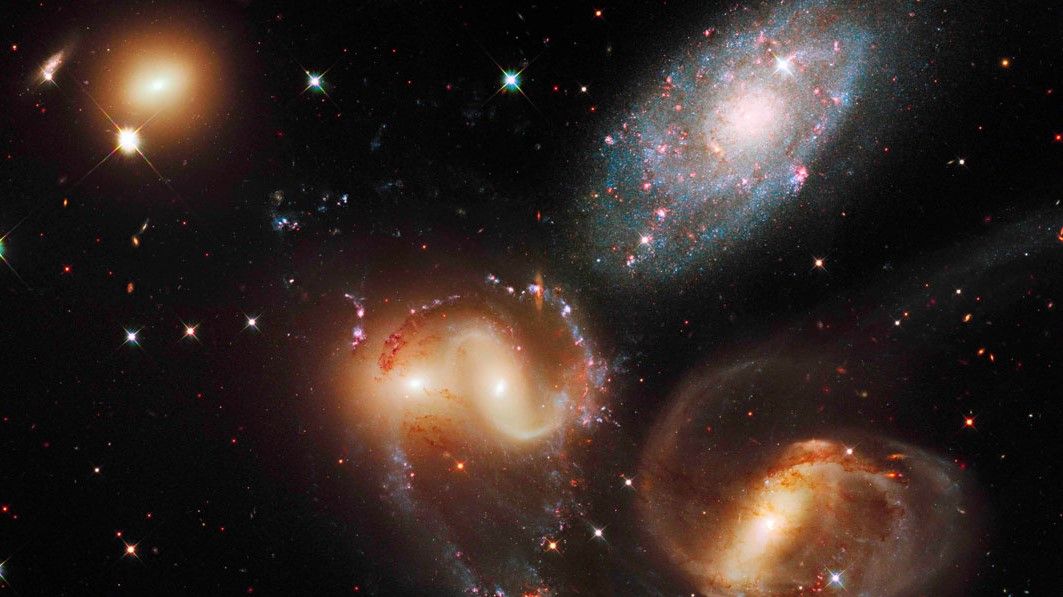Welcome to DU!
The truly grassroots left-of-center political community where regular people, not algorithms, drive the discussions and set the standards.
Join the community:
Create a free account
Support DU (and get rid of ads!):
Become a Star Member
Latest Breaking News
Editorials & Other Articles
General Discussion
The DU Lounge
All Forums
Issue Forums
Culture Forums
Alliance Forums
Region Forums
Support Forums
Help & Search
Science
Related: About this forumHubble Space Telescope discovers 11-billion-year-old galaxy hidden in a quasar's glare
By Robert Lea published about 6 hours ago
Astronomers normally observe galaxies by observing light these objects emit, but some tricky galaxies require a different approach.

A galaxy grouping called Stephan’s Quintet, which contains an imposter galaxy that is actually much closer to Earth than the others. (Image credit: NASA, ESA, and the Hubble SM4 ERO Team)
Using the Hubble Space Telescope, a team of astronomers has used a tricky technique to discover an elusive 11-billion-year-old galaxy. Rather than observe the light this realm emits, they watched for the light it absorbs.
Just as we see a light bulb via the light it emits, astronomers usually observe galaxies using the light their stars emit. Galaxies put out light waves found across the entire electromagnetic spectrum, and different telescopes are able to observe these cosmic objects in different wavelengths of light to form a full picture.
But, when a galaxy is located along the same line of sight as another, more distant, source of bright light, there's another way to go about these galactic observations. As light passes through a background galaxy toward a foreground galaxy, for instance, gas and dust in the foreground galaxy will absorb some of the background one's wavelengths. And because chemical elements absorb light at specific wavelengths, looking for gaps in the light output — or spectra — from a background source can tell astronomers what that light had passed through on its way to our telescopes. In other words, light in those "gaps" would've been absorbed by a foreground object on the way to our vantage point.
One potentially useful background source for this technique are quasars, which are extremely bright galactic hearts powered by supermassive black holes blasting out jets of radiation and matter as they feast on surrounding material.
More:
https://www.space.com/hubble-elusive-11-billion-year-old-galaxy-light-absorption
InfoView thread info, including edit history
TrashPut this thread in your Trash Can (My DU » Trash Can)
BookmarkAdd this thread to your Bookmarks (My DU » Bookmarks)
2 replies, 1435 views
ShareGet links to this post and/or share on social media
AlertAlert this post for a rule violation
PowersThere are no powers you can use on this post
EditCannot edit other people's posts
ReplyReply to this post
EditCannot edit other people's posts
Rec (8)
ReplyReply to this post
2 replies
 = new reply since forum marked as read
Highlight:
NoneDon't highlight anything
5 newestHighlight 5 most recent replies
= new reply since forum marked as read
Highlight:
NoneDon't highlight anything
5 newestHighlight 5 most recent replies
Hubble Space Telescope discovers 11-billion-year-old galaxy hidden in a quasar's glare (Original Post)
Judi Lynn
Sep 2023
OP
keithbvadu2
(39,385 posts)1. Found by lack of proof.
WestMichRad
(1,618 posts)2. I am repeatedly amazed...
… at how they are able to decipher the data and describe the amazing phenomena in the universe. Just amazing- both the technological and our universe!
Using galaxies as lenses or filters to find and learn about even more distant galaxies is (are?) a very nifty trick!